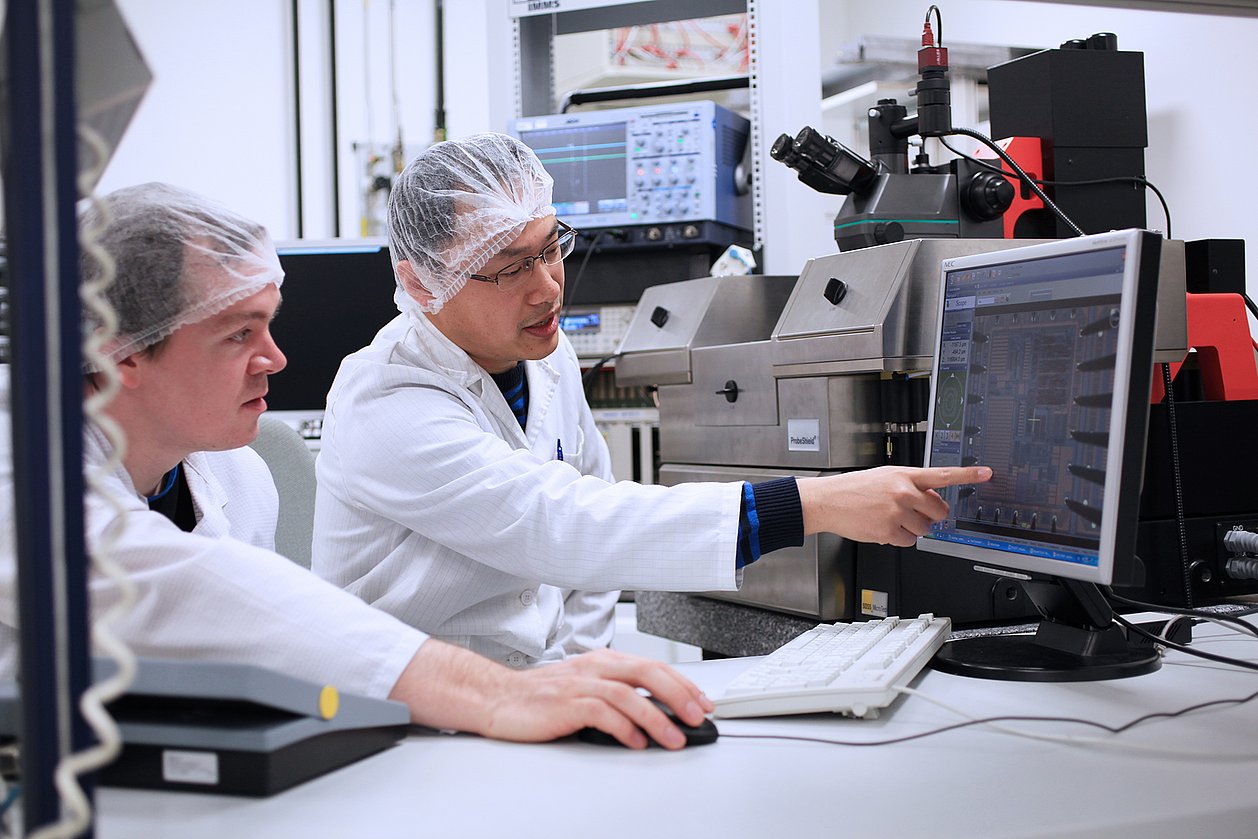Project MEDIKIT
IMMS has developed a chip for mobile diagnostic systems for the early detection of diseases using time-resolved fluorescence measurements.
IMMS chip development for point-of-care devices of the medical technology industry
The earlier and more reliably cancer and heart diseases can be diagnosed, the higher the chances of successful therapies. From 2011 to 2016, one in four deaths in the EU was caused by these diseases. In this context, new and efficient methods in early detection are necessary. To advance these methods, IMMS has been working on a chip for a portable modular analysis system for quantitative personalised diagnostics of societal diseases in the joint project MEDIKIT. The goal was a point-of-care device that detects biomarkers in the shortest possible time and can be operated directly at the doctor's office without additional reagents, devices or materials. The basis was formed by the molecular biological and immunological assays for the detection of various biomarkers, on which the project partners Senova and Oncgnostics worked.
Lock-in imager for time-resolved fluorescence imaging with europium
In in-vitro diagnostics, the labeling of target analytes with fluorescent dyes is becoming increasingly common, as they can be easily distinguished from background and interfering signals. In the MEDIKIT project, IMMS has developed a lock-in imager chip for time-resolved fluorescence imaging with europium and integrated it into an example application for digital readout of test strips. Those tests, also called lateral flow assays (LFA), play an important role in in-vitro diagnostics. They are cost-effective, easy to handle and therefore perfectly suited for decentralised and time-critical diagnostics. They are widely used as pregnancy or COVID-19 rapid tests, among others, to make qualitative conclusions (positive or negative). However, quantitative information on concentrations and ratios are needed for many diagnostic questions. Common LFA reader combinations with classical dye particles such as gold are not sensitive enough for this purpose. New LFA reader combinations with europium markers offer much higher readout sensitivities, which are supported by our imager. Thanks to its lock-in principle, elaborate optical filters can be omitted.
The europium, in the demonstrator on a strip test, is optically excited by a light source and emits photons that are detected by the chip. In time-resolved fluorescence measurement, this emission is measured after the excitation light has decayed and is accumulated over several excitation cycles. In this way, even very low fluorescence can be quantitatively detected and thus higher sensitivities of the sensor can be achieved.
The modular and mobile test systems of IMMS were used and further developed for the test and characterisation of the developed lock-in imager chip.
Acronym / Name:
MEDIKIT / Mobile diagnostic systems for widespread diseasesDuration:2018 – 2021
Application:
Life Sciences|Cervical cancer| heart attack| fluorescenceResearch field:Integrated sensor systems
Related content
Lock-In Pixel CMOS Image Sensor for Time-Resolved Fluorescence Readout of Lateral-Flow Assays
Alexander Hofmann1. Benjamin Saft1. Peggy Reich1. Martin Grabmann1. Georg Gläser1. Max Trübenbach2. Alexander Rolapp1. Marco Reinhard1. Friedrich Scholz2. Eric Schäfer1.IEEE Transactions on Biomedical Circuits and Systems, vol. 16, no. 4, pp. 535-544, Aug. 2022, DOI: doi.org/10.1109/TBCAS.2022.3192926
1IMMS Institut für Mikroelektronik- und Mechatronik-Systeme gemeinnützige GmbH, 98693 Ilmenau, Germany. 2Senova Gesellschaft für Biowissenschaft und Technik mbH, Germany.Zeitaufgelöste Fluoreszenz für genaue und mobile In-vitro-Diagnostik
Eric Schäfer1. Benjamin Saft1.DeviceMed, Das Community-Magazin, Jahrgang 17, Ausgabe 6, November 2021, Seite 40 - 41, www.devicemed.de, ISSN 1860-9414 | 69029
1IMMS Institut für Mikroelektronik- und Mechatronik-Systeme gemeinnützige GmbH, 98693 Ilmenau, Germany.Filterless TRF Reader with CMOS Sensor ASIC for Lateral Flow Immunoassays
Alexander Hofmann1. Peggy Reich1. Martin Grabmann1. Georg Gläser1. Max Trübenbach2. Alexander Rolapp1. Marco Reinhard1. Friedrich Scholz2. Eric Schäfer1.2021 IEEE Biomedical Circuits and Systems Conference (BioCAS), 2021, pp. 1-6, doi.org/10.1109/BioCAS49922.2021.9645000, 6 - 9 October 2021, Berlin, Germany, virtual conference
1IMMS Institut für Mikroelektronik- und Mechatronik-Systeme gemeinnützige GmbH, 98693 Ilmenau, Germany. 2Senova Gesellschaft für Biowissenschaft und Technik mbH, Weimar, Germany.Will There be Light? - Simulative Prediction of Fluorescence Measurements
Florian Kögler1. Alexander Hofmann1. Georg Gläser1.2019 16th International Conference on Synthesis, Modeling, Analysis and Simulation Methods and Applications to Circuit Design (SMACD), Lausanne, Switzerland, 15 - 18 July 2019, pp. 157-160.
1IMMS Institut für Mikroelektronik- und Mechatronik-Systeme gemeinnützige GmbH, 98693 Ilmenau, Germany.

Press release,
CMOS image sensor platform for time-resolved fluorescence measurements with europium
Quantitative readout of test strips demonstrates broad applicability in in-vitro diagnostics

Event,
IID 2023
Industry Innovation Dialogue: New paths in microelectronics – diversification for more resilience

Event,
InnoCON Thüringen 2021
Die diesjährige InnoCON steht unter dem Motto „Mit der Thüringer Innovationsstrategie 2021 – 2027 die Herausforderungen unserer Zeit wie die digitale Transformation und die Dekarbonisierung angehen.“

Event,
IEEE BioCAS 2021
Biomedical Circuits and Systems Conference (BioCAS): Restoring Vital Functions by Electronics – Achievements, Limitations, Opportunities, and Challenges
Contact
Contact
Eric Schäfer, M. Sc.
Head of Microelectronics / Branch Office Erfurt
eric.schaefer(at)imms.de+49 (0) 361 663 25 35
Eric Schäfer and his team research Integrated sensor systems, especially CMOS-based biosensors, ULP sensor systems and AI-based design and test automation. The results are being incorporated into research on the lead applications Sensor systems for in-vitro diagnostics and RFID sensor technology. It will assist you with services for the development of Integrated circuits and with IC design methods.
Funding
The project on which these results are based was supported by the German ”Land“ of Thüringen and co-financed by European Union funds within the framework of the European Regional Development Fund (ERDF) under the reference 2017 FE 9044.
















